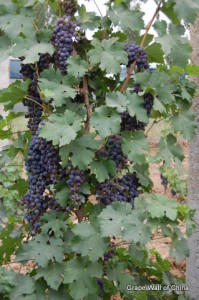
–
By Jim Boyce
The past few months, I have been lucky to visit wineries along the northern swath of China – in Xinjiang, Ningxia, Shanxi, and Hebei. One thing I notice: the wines made by many producers do not always reflect the skill of the wine makers. As they say, you can’t make an omelet without breaking some eggs, and you can’t make good wine without some decent grapes. I wrote about this recently for The Global Times. In short, I noted three challenges many wine makers have in China:
1. Because wine producers source most of their grapes from farmers and pay by weight, the farmers grow as much fruit as possible rather than sacrificing some it to improve the remainder. Quantity over quality.
2. In some areas – notably Hebei and Shandong provinces, two of the country’s biggest wine making areas – the grapes may be picked as many as two weeks too early.
3. And some Chinese wine producers, notably the big ones, blend in imported bulk wine. This can actually improve overall wine quality, but could wreak havoc on consistency since, in a given year, the sources can change – last year, Chile and Argentina dominated, this year Chile and Australia are on top, and eight years ago two-thirds came from Spain.
The obvious questions is: Why do consumers tolerate this poor wine? Because many of them buy wine for health and status reasons, rather than taste. For more details on this, see the article.
Grape Wall has no sponsors of advertisers: if you find the content and projects like World Marselan Day worthwhile, please help cover the costs via PayPal, WeChat or Alipay.
Sign up for the free Grape Wall newsletter here. Follow Grape Wall on LinkedIn, Instagram, Facebook and Twitter. And contact Grape Wall via grapewallofchina (at) gmail.com.

@ joe,
Agree, all these factors – marketing, availability, and associations with status – determine what consumers drink. Thus, for many consumers, they drive the market and taste is in the back seat.
Cheers, Jim
i don’t think chinese drink wine just for health reason, but definitely not totally fot the taste. Many people drink for fashion and showing a “higher taste” then those who drink beer. Another factor causing this problem is most people will not go to a wine shop to get a bottle of wine but rather shop in the supermarkets or order wines in the restaurant where generic chinese wine dominates the options. Marketing is another important factor as the big heads put lots of resources on TV tv commercials and Ads to “educate” consumers who haven’t taste wine before and make them believe a wine should taste like that.
@ Dimitri,
Thanks for the info.
I know others, such as China Silk, are making wine in Xinjiang for export as well. There is a good deal of potential in this region.
Cheers, Jim
The wineries need to work closely with the farmers to teach them about quality over quantity…and of course, pay more for it. Take Grace Vineyards as the primary example. They produce a quality product, and yes you pay more for it. If poor quality wines are exported to America, it will be a laughing stock and won’t last long. But creating wines that consumers enjoy will make people sit back and say “wow, this Chinese wine is very good!” Unlike some other Chinese products, wine should pay close attention to the world market and not try to cut corners.
I have tasted the Suntime wines also. In the “everyday drinking wine” category, they have a good chance of doing well…but they absolutely MUST pay close attention to quality.
Dear Mr Boyce,
I really appreciate your synthetic analysis. It’s 100% correct.
We made such analysis about 5 years before and it leads us to choose to export SUNTIME (Xintian) wines from Xinjiang, now CITIC Guoan wine co, ltd to Europe instead of one of the big 3 brands.
SUNTIME never imported bulk wine from abroad and only relies on its vineyards (10’000 hectares). This is a guarantee for us to always have the same wine taste, palate and identity.
Wine maker (Mr Fred Nauleau) also tries to impose step by step to harvest as latest as possible and to reduce quantities when harvest, thus in order to improve grapes quality.
In consequence, and this has been recently published in other website, SUNTIME is nowadays the number 1 Chinese wine brand in Europe and clients such as “Le Carrousel du Louvre’s” restaurant selected SUNTIME as their wine offer in their Asian athmosphere restaurants…as many many others restaurants in France (more than 200 nowadays).
We strongly believe to export by end 2011, several millions SUNTIME wines bottles to Europe.
Thanks for your analysis again.
Best regards,
Dimitri Pérez
CWS&BF Manager